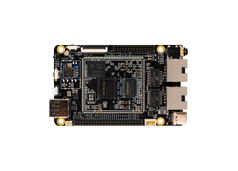7. PWM¶
7.1. Introduction¶
This chapter describes how to configure PWM.
The PWM driver of ROC-RK3506B-CC is kernel/drivers/pwm/pwm-rockchip.c
7.2. DTS configure¶
There are three main steps to configure PWM: configure PWM DTS node, configure PWM kernel driver and control PWM device.
7.2.1. Configure PWM DTS node¶
Add the PWM DTS configuration in the DTS source file kernel/arch/arm/boot/dts/rk3506b-firefly-roc-rk3506b-cc-mipi101-BSD1218-A101KL68.dtsi, as shown below:
/{
backlight: backlight {
compatible = "pwm-backlight";
enable-gpios = <&pca9555 PCA_IO0_1 GPIO_ACTIVE_HIGH>;
pwms = <&pwm0_4ch_2 0 50000 1>; //pwm0_4ch_2:PWM number 0 50000:PWM period in nanoseconds 1:polarity
...
};
&pwm0_4ch_2 {
pinctrl-names = "active";
pinctrl-0 = <&rm_io3_pwm0_ch2>;
status = "okay";
};
PWM parameter analysis:
&pwm0_4ch_2: defined in rk3502.dtsi.
0: indicates chip index, usually 0, because there is only one rockchip PWM chip per chip.
50000: one cycle time is 100000000 nanoseconds, there are 10 100000000 nanoseconds in one second, so the PWM output cycle is 20000Hz.
1: indicates polarity, 0 is normal polarity, 1 is reverse polarity.
7.3. Interface Specification¶
Users can use the PWM nodes generated by the above steps in other driver files. The specific methods are as follows:
(1) The following header files are included in the device driver files that need to be controlled by PWM :
#include <linux/pwm.h>This header file mainly contains the PWM function interface.
(2) Apply PWM
Using:
struct pwm_device *devm_pwm_get(struct device *dev, const char *con_id);
Function to apply for PWM. Such as:
struct pwm_device * pwm0 = devm_pwm_get(&pdev->dev, NULL);
(3) Configue PWM
Using:
int pwm_config(struct pwm_device *pwm, int duty_ns, int period_ns);
Configure the duty cycle of PWM, for example:
pwm_config(pwm0, 500000, 1000000);
(4) Enable the PWM function
int pwm_enable(struct pwm_device *pwm);
Used to enable PWM, for example:
pwm_enable(pwm0);
(5) Control PWM output mainly uses the following interface functions:
function: Used to apply for PWM
struct pwm_device *pwm_request(int pwm_id, const char *label);
function: Used to release the PWM requested
void pwm_free(struct pwm_device *pwm);
function: Used to configure the duty cycle of PWM
int pwm_config(struct pwm_device *pwm, int duty_ns, int period_ns);
function: Enable PWM
int pwm_enable(struct pwm_device *pwm);
function: Ban PWM
void pwm_disable(struct pwm_device *pwm);
7.4. Debug method¶
Check PWM registration status through the rich debug interface of the kernel, adb shell or serial port to enter the android terminal and execute:
cat /sys/kernel/debug/pwm
To see if the registration was successful, the interface name and register address are returned.
7.5. FAQs¶
Q1: Pwm could not register successfully ?
A1:
whether the DTS configuration file opens the corresponding PWM.
whether the IO port where PWM is located is occupied by other resources, you can check the reason according to the error return value.
